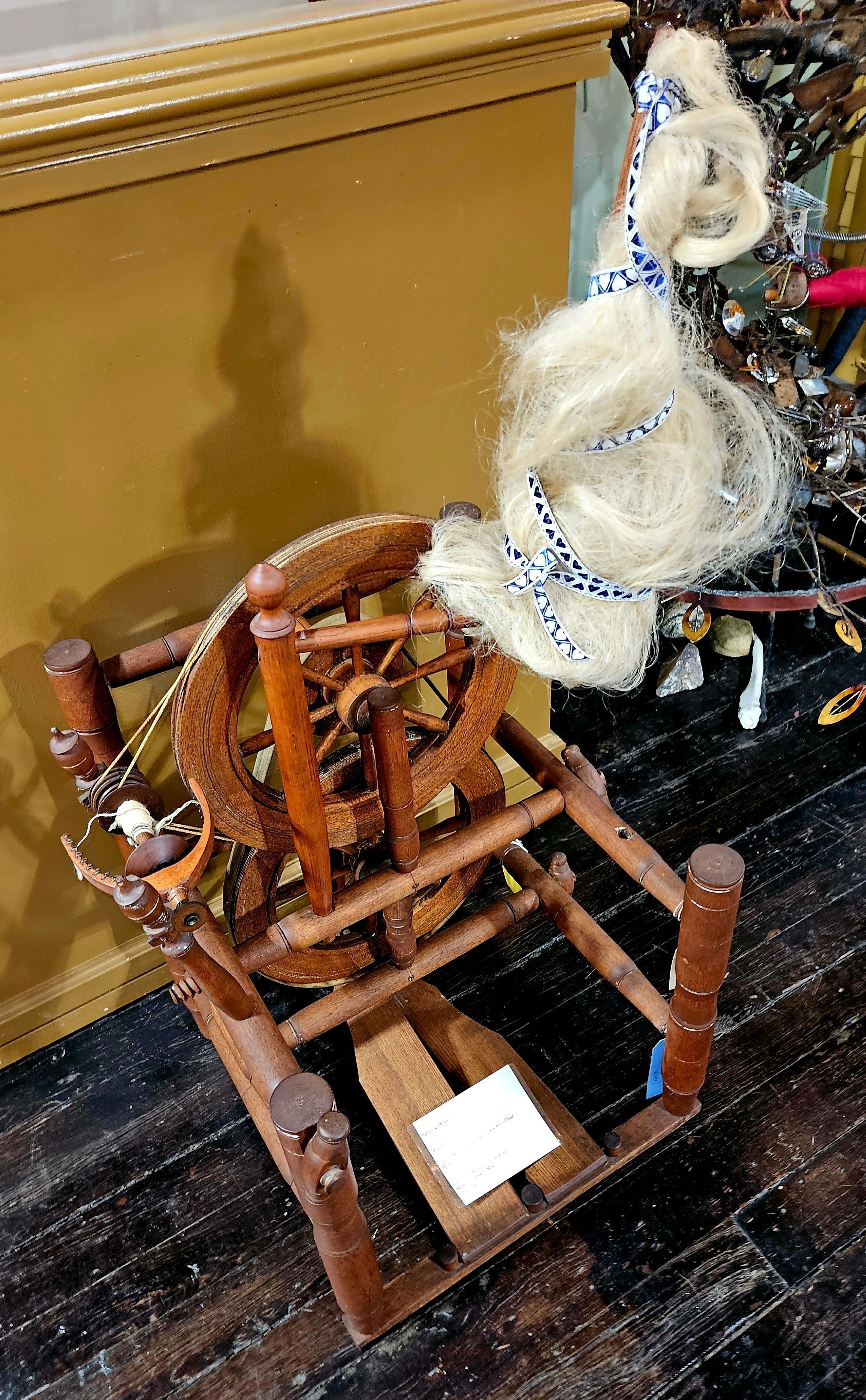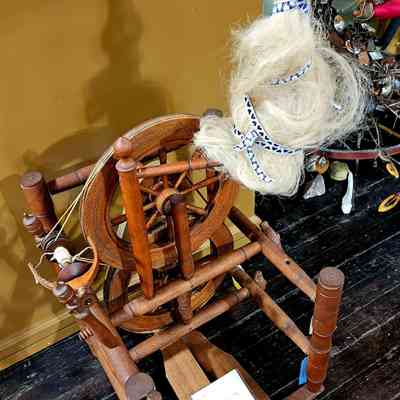Name/Title
Connecticut Chair Spinning WheelEntry/Object ID
2017.01.11Description
From American Textile History Museum catalog, describing this wheel: "Connecticut chair spinning wheel. Horizontal bobbin and flyer. Early 19th century. Two wheels, two treadles, chair frame. Chair frame has two high posts in back and two shorter posts in front, connected by two parallel stretchers on each side. Two parallel stretchers connect the back posts; two parallel horizontal rods are threaded through side stretchers, secured by wooden nuts. A fixed flat board between the front posts holds three small uprights. Each of the two treadles pivots on a metal rod between them. Each footman connects to a z-shaped drive wheel axle extension, which fits into the lower rear stretcher. The front wheel post fits through the lower horizontal rod. The drive wheel has six spokes; the rim is constructed in four sections. The wheel post for the accelerating wheel is set into the top horizontal rod. The accelerating wheel, attached to the wheel post and the upper back stretcher, has six spokes; the rim, with two grooves, is constructed in four sections. A solid disk, with a single groove, is attached to the accelerating wheel hub extension. A cloth belt connects the drive wheel to this disk. A double drive-band connects the accelerating wheel to the whorls. The mother-of-all is set between the front and back posts on the spinner's left. A tension knob on the front post adjusts its position. The bobbin/flyer is complete and connected by a doubled drive-band to the accelerating wheel. Conical shaped distaff assembly set into upper horizontal rod. Turnings on legs."
From Joan Whittaker Cummer, "A Book of Spinning Wheels" (Portsmouth, NH: Peter E. Randall, 1993), p. 156, describing this wheel: "Connecticut Chair Wheels are an American invention of the early nineteenth century supposedly first made in Connecticut by a chair maker. The double treadle and the action of the accelerating wheel allow a slow easy treadling rhythm while spinning. At the axle a small solid wooden wheel in attached to the upper wheel. A drive band passing around the rim of the lower wheel and the rim of the small solid wheel, transfers the action of the treadle to the large upper wheel. A double drive band passes from the rim of the upper wheel around the bobbin and flyer whorls in the customary manner. The mother-of-all, threaded at each end, passes through the front left hand post where it is secured by a threaded handle. This allows the tension on the double drive band to be easily adjusted. This seems to be the earliest use of a rocker tensioner. There is one place for a distaff carrier placed at the top horizontal bar behind the wheels."Use
Spinning fiber (especially flax) into yarn or thread.Context
Preindustrial textile technology.Collection
American Textile History Museum CollectionMade/Created
Date made
circa 1800 - circa 1850Time Period
19th CenturyPlace
State/Province
Connecticut* Untyped Place
New EnglandLexicon
Nomenclature 4.0
Nomenclature Primary Object Term
Wheel, SpinningNomenclature Sub-Class
Textile Manufacturing EquipmentNomenclature Class
Textileworking T&ENomenclature Category
Category 04: Tools & Equipment for MaterialsOther Names and Numbers
Other Numbers
Number Type
ATHMOther Number
1991.178.71Dimensions
Height
29 inWidth
17-1/2 inDepth
19 inMaterial
Wood, Ferrous metalLocation
Location
Exhibit Room
Bev York Room* Untyped Location
Main Museum BuildingCategory
ExhibitDate
April 4, 2025Provenance
Provenance Detail
In 1991 the object was donated to the American Textile History Museum by Joan Cummer.Role
Collector, handspinnerPlace
State/Province
New Hampshire* Untyped Place
New EnglandAcquisition Method
Donation, ATHMAcquisition Date
2017Created By
historian@millmuseum.orgCreate Date
April 4, 2025Updated By
historian@millmuseum.orgUpdate Date
April 4, 2025
